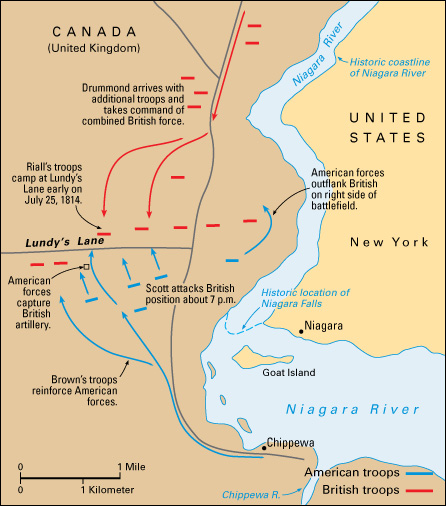Lundy’s Lane, Battle of, was one of the bloodiest and hardest fought battles of the War of 1812 (1812-1815). The battle took place on July 25, 1814, in what is now southeastern Ontario, Canada. The battlefield was about 1 mile (1.6 kilometers) from Niagara Falls. American forces led by Major General Jacob Brown fought British forces led by Lieutenant General Gordon Drummond. Both sides claimed victory, but the Americans withdrew from the battlefield after the battle. Lundy’s Lane was a road on the battlefield.
Background.
American invasions of Canada, at that time a possession of the United Kingdom, had failed in 1812 and 1813. Better-trained American troops invaded again in 1814. On July 3, General Brown led American forces across the Niagara River and captured Fort Erie, a British outpost. Two days later, the Americans defeated British forces at the Battle of Chippewa. Chippewa (also spelled Chippawa) is the name of a village and river about 16 miles (26 kilometers) north of Fort Erie. American Brigadier General Winfield Scott was the hero of the Chippewa victory. The leader of the British troops at Chippewa was Major General Phineas Riall.
After the Battle of Chippewa, Brown chased Riall’s forces farther north. However, additional British troops reinforced Riall, and the Americans retreated back to the Chippewa River. Riall followed Brown. On the morning of July 25, he and about 1,100 troops camped at Lundy’s Lane, about 3 miles (4.8 kilometers) north of the river. Lundy’s Lane was a small road that branched off a main route that ran along the Niagara River.
In the afternoon, Brown sent General Scott, with about 1,080 American troops, north toward the British. The Americans were unaware of the size of the British force at Lundy’s Lane. American scouts located Riall’s position. As Scott prepared to attack, General Drummond arrived with additional British troops. Drummond took control of the combined British force, which now numbered about 1,900 men.

The battle.
The Americans attacked at about 7 p.m. Outnumbered, Scott asked for reinforcements. As the battle raged on, about 1,600 troops under Brown strengthened the American force. At about the same time, another 1,700 of Drummond’s soldiers also arrived. Much of the action took place after nightfall.
Early in the battle, Riall was wounded and captured by the Americans. American soldiers later captured the British artillery (field guns). The Americans repulsed repeated British attempts to recapture their artillery.
Both Brown and Scott were wounded in the fighting. About midnight, Brigadier General Eleazar Wheelock Ripley, the next highest ranking American officer, withdrew the Americans from the battlefield. The Americans left the British artillery behind. The next morning, the British retook the field and regained their artillery. Each side claimed victory.
The aftermath.
Over the course of the Battle of Lundy’s Lane, 173 Americans were killed. Another 571 were wounded, and 117 were captured or missing. Scott’s severe wound kept him out of the rest of the war. The British suffered 84 soldiers killed, 559 wounded, and 235 captured or missing.
The day after the battle, the Americans withdrew to Fort Erie. They held Fort Erie until November 5, when they withdrew to the American side of the Niagara River. The Americans made no further attempts to invade Canada during the war.
See also Brown, Jacob Jennings ; Chippewa, Battle of ; Scott, Winfield ; War of 1812 .
